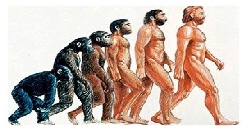1. Is Darwin’s theory of evolution a proven fact?
NO! Darwin’s theory of natural selection states that more complex creatures have evolved from less complex creatures through a completely natural process of favorable adaptation. Yet this theory has never been proven and cannot be replicated in a laboratory setting. In fact, as scientific knowledge increases, so do the questions and problems which confront Darwinian

evolution. For instance, when Darwin first formulated his theory of evolution it was assumed that a single cell was a simple thing; being comprised of nothing more than a few compounds. Yet recent studies have shown that a single cell is an exceedingly complex structure containing thousands of organic molecules that combine in detailed and specific ways to carry out various functions within the cell itself. Every single cell contained within every living thing is a virtual “universe” unto itself. Darwin’s theory may sound plausible when given as a possible explanation of how an ape supposedly evolved into a man. But, it cannot explain how these complex and specific differentiations occurred at the cellular level. There is no scientific proof or laboratory experiment which has ever demonstrated how these supposed changes have occurred at the cellular level.
2. Doesn’t the fossil record support Darwin’s theory?

NO! If evolution is correct the fossil record should contain numerous “transitional forms” between the many distinct animal families which exist today. Yet the fossil record contains no such transitional forms. Darwin himself recognized this problem when he wrote:
“Geology assuredly does not reveal any such finely-graduated organic chain; and this, perhaps, is the most obvious and serious objection which can be urged against the theory. The explanation lies, as I believe, in the extreme imperfection of the geological record.” (The Origin of the Species)
Close to a century and a half later, there still is not any significant progress made in discovering these transitional forms. All that the modern-day evolutionist can do is make the same weak excuse as Darwin when he stated that the reason for this total lack of actual fossil evidence lies within “the extreme imperfection of the geological record”. In fact, many evolutionists readily admit that the fossil record actually gives stronger evidence for the biblical account of creation because fossils tend to suddenly appear as if they were simply created. Likewise, these fossils, even though they are often of animals that have long been extinct, are just as complex as their modern-day counterparts. The fossil record actually gives evidence that life appeared suddenly and at levels of organic complexity that are equal to anything living today.
3. Was there a gradual change of ape to modern man?

NO! Despite the fact that the illustration here is standard fare in most modern-day textbooks, there is simply no evidence to support it. Several missing links have been “discovered” over the many decades since Darwin first proposed his theory. They invariably prove to either be outright hoaxes, or they are merely another form of ape and thus not a transitional form between ape and human.
4. Doesn’t the similarity of skeletal structure from reptiles to birds to mammals prove that evolution had to have occurred?

NO! While there is an amazing similarity, this of itself doesn’t prove that all organisms slowly evolved from a common ancestor. One could line up several generations of automobiles, starting with ones that are very old and progressing to ones that modern. Here too one would notice a striking similarity in how all these cars, from old to new, are designed and put together. Yet no one would claim that such similarity was due to completely natural forces and that these cars all just spontaneously evolved into the forms that we presently see. Similarity in design simply shows that the basic design of the automobile is sound and doesn’t need major revision. In the same way skeletal similarities between various animals simply demonstrate the soundness of God’s design in His creation.


